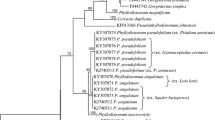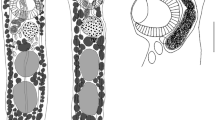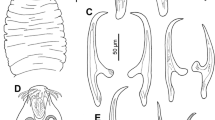Abstract
Using novel molecular and morphological data we elucidated the life-cycle of Gorgocephalus yaaji Bray & Cribb, 2005 from off Lizard Island, on the northern Great Barrier Reef, Australia. ITS2 rDNA sequences generated for larval trematodes from the infected snail species Echinolittorina austrotrochoides Reid (Littorinidae) were identical to those from adult G. yaaji from the fish Kyphosus cinerascens (Forsskål) (Kyphosidae). Cercariae develop in rediae in E. austrotrochoides, emerge from the snail, encyst on algae as metacercariae, and are inferred to then be consumed by the herbivorous definitive fish host, K. cinerascens. In addition, we generated the first ITS2 rDNA sequences for a gorgocephalid previously reported from the littorind gastropod Austrolittorina unifasciata Gray. Although infections previously reported from A. unifasciata were the first larval gorgocephalids characterised, this study is the first to connect an intramolluscan infection to a sexual adult. In light of the new life-cycle information, a review of mollusc associations for the digenean superfamily Lepocreadioidea was performed, highlighting gaps in the knowledge and revealing patterns of host-parasite association. We find that distinct patterns of first intermediate host association are discernible for three lepocreadioid lineages: the Aephnidiogenidae Yamaguti, 1934, Gorgocephalidae Manter, 1966, and the Lepocreadiidae Odhner, 1905. However, the evolutionary origin for these patterns of host association remains unclear.


Similar content being viewed by others
References
Abdul-Salam, J., & Sreelatha, B. (1998). A list of larval digenetic trematodes parasitizing some marine invertebrates of Kuwait Bay. Kuwait Journal of Science & Engineering, 25, 409–434.
Al-Jahdali, M., & El-Said Hassanine, R. (2012). The life cycle of Gyliauchen volubilis Nagaty, 1956 (Digenea: Gyliauchenidae) from the Red Sea. Journal of Helminthology, 86, 165–172.
Anderson, G. R., & Barker, S. C. (1998). Inference of phylogeny and taxonomy within the Didymozoidae (Digenea) from the second internal transcribed spacer (ITS2) of ribosomal DNA. Systematic Parasitology, 41, 87–94.
Averbuj, A., & Cremonte, F. (2010). Parasitic castration of Buccinanops cochlidium (Gastropoda: Nassariidae) caused by a lepocreadiid digenean in San José Gulf, Argentina. Journal of Helminthology, 84, 381–389.
Bartoli, P. (1967). Etude du cycle évolutif d’un Trématode peu connu: Lepocreadium pegorchis (M. Stossich, 1900) (Trematoda, Digenea). Annales de Parasitologie Humaine et Comparée, 42, 605–619.
Bartoli, P., & Gibson, D. I. (2007). Synopsis of the life cycles of Digenea (Platyhelminthes) from lagoons of the northern coast of the western Mediterranean. Journal of Natural History, 41, 1553–1570.
Bartoli, P., & Prévôt, G. (1978). Le cycle biologique de Holorchis pycnoporus M. Stossich, 1901 (Trematoda, Lepocreadiidae). Zeitschrift für Parasitenkunde, 58, 73–90.
Bartoli, P., & Holmes, J. C. (1997). A transmission study of two sympatric digeneans: Spatial constraints and solutions. Journal of the Helminthological Society of Washington, 64, 169–175.
Bayssade-Dufour, C., & Maillard, C. (1974). Chetotaxie de quatre cercaires d’ Allocreadioidea. Annales de Parasitologie Humaine et Comparée, 49, 521–554.
Blair, D., Davis, G., & Wu, B. (2001). Evolutionary relationships between trematodes and snails emphasizing schistosomes and paragonimids. Parasitology, 123, 229–243.
Bowles, J., Hope, M., Tiu, W. U., Liu, X., & McManus, D. P. (1993). Nuclear and mitochondrial genetic markers highly conserved between Chinese and Philippine Schistosoma japonicum. Acta Tropica, 55, 217–229.
Bray, R. A. (2005). Family Gorgocephalidae Manter, 1966. In: Jones, A., Bray, R. A., & Gibson, D. I. (Eds.), Keys to the Trematoda. Volume 2. Wallingford: CABI International, pp. 657–661.
Bray, R. A., & Cribb, T. H. (2000). The status of the genera Hysterolecithoides Yamaguti, 1934, Neotheletrum Gibson & Bray, 1979 and Machidatrema León-Règagnon, 1998 (Digenea: Hemiuroidea), including a description of M. leonae n. sp. from Australian waters. Systematic Parasitology, 46, 1–22.
Bray, R. A., & Cribb, T. H. (2001). A review of the family Enenteridae Yamaguti, 1958 (Digenea), with descriptions of species from Australian waters, including Koseiria huxleyi n. sp. Systematic Parasitology, 48, 1–29.
Bray, R. A., & Cribb, T. H. (2002a). Further observations on the Enenteridae Yamaguti, 1958 (Digenea, Lepocreadioidea) of the Indo-West Pacific region, including a new species from Western Australia. Acta Parasitologica, 47, 208–223.
Bray, R. A., & Cribb, T. H. (2002b). Observations on the phylogeny of Opisthadena Linton, 1910 and related genera (Hemiuridae: Opisthadeninae) from Australian and French Polynesian waters. Folia Parasitologica, 49, 279–290.
Bray, R. A., & Cribb, T. H. (2005). Gorgocephalus yaaji n. sp. (Digenea: Gorgocephalidae) from the brassy chub Kyphosus vaigiensis (Perciformes: Kyphosidae) off Lizard Island, northern Great Barrier Reef and further records of G. kyphosi. Zootaxa, 1068, 39–46.
Bray, R. A., & Cribb, T. H. (2012). Reorganisation of the superfamily Lepocreadioidea Odhner, 1905 based on an inferred molecular phylogeny. Systematic Parasitology, 83, 169–177.
Cable, R. M. (1956). Marine cercariae of Puerto Rico. Scientific Survey of Porto Rico and the Virgin Islands, 16, 491–577.
Cable, R. M. (1963). Marine cercariae from Curaçao and Jamaica. Zeitschrift für Parasitenkunde, 23, 429–469.
Cable, R. M., & Hunninen, A. (1942). Studies on Deropristis inflata (Molin), its life history and affinities to trematodes of the family Acanthocolpidae. Biological Bulletin, 82, 292–312.
Cannon, L. (1978). Marine cercariae from the gastropod Cerithium moniliferum Kiener at Heron Island, Great Barrier Reef. Proceedings of the Royal Society of Queensland, 89, 45–57.
Ching, H. L. (1991). Lists of larval worms from marine invertebrates of the Pacific Coast of North America. Journal of the Helminthological Society of Washington, 58, 57–68.
Choudhury, A., & Dick, T. A. (1998). Systematics of the Deropristiidae Cable & Hunninen, 1942 (Trematoda) and biogeographical associations with sturgeons (Osteichthyes: Acipenseridae). Systematic Parasitology, 41, 21–39.
Clements, K., & Choat, J. (1997). Comparison of herbivory in the closely-related marine fish genera Girella and Kyphosus. Marine Biology, 127, 579–586.
Colgan, D., Ponder, W., Beacham, E., & Macaranas, J. (2007). Molecular phylogenetics of Caenogastropoda (Gastropoda: Mollusca). Molecular Phylogenetics and Evolution, 42, 717–737.
Cribb, T. H., Adlard, R. D., & Bray, R. A. (1998). A DNA-based demonstration of a three-host life-cycle for the Bivesiculidae (Platyhelminthes: Digenea). International Journal for Parasitology, 28, 1791–1795.
Cribb, T. H., Bray, R. A., & Littlewood, D. T. J. (2001). The nature and evolution of the association among digeneans, molluscs and fishes. International Journal for Parasitology, 31, 997–1011.
Cribb, T. H., & Bray, R. A. (2010). Gut wash, body soak, blender and heat-fixation: Approaches to the effective collection, fixation and preservation of trematodes of fishes. Systematic Parasitology, 76, 1–7.
Criscione, F., & Ponder, W. F. (2013). A phylogenetic analysis of rissooidean and cingulopsoidean families (Gastropoda: Caenogastropoda). Molecular Phylogenetics and Evolution, 66, 1075–1082.
Cunha, R. L., Grande, C., & Zardoya, R. (2009). Neogastropod phylogenetic relationships based on entire mitochondrial genomes. BMC Evolutionary Biology, 9, 210.
Deblock, S. (1980). Inventaire des trématodes larvaires parasites des mollusques Hydrobia (Prosobranches) des côtes de France. Parassitologia, 22, 1–105.
Granovitch, A. I., & Mikhailova, N. A. (2004). Rocky shore trematodes of the west coast of Sweden: Distribution and life cycle strategies. Acta Parasitologica, 49, 228–236.
Hall, K. A., & Cribb, T. H. (2005). Family Gyliauchenidae Fukui, 1929. In: Jones, A., Bray, R. A., & Gibson, D. I. (Eds.) Keys to the Trematoda. Volume 2. Wallingford, CABI International, pp. 665–678.
Hanafy, M., Gab-Alla, A., & Hassanine, R. (1997). Larval trematode (Digenea: Lepocreadiidae) infection in the gonads of the commercial bivalve Venerupis decussata from Lake Timsah, Suez Canal. Journal of the Egyptian-German Society of Zoology, 24, 167–182.
Harasewych, M., Adamkewicz, S. L., Blake, J. A., Saudek, D., Spriggs, T., & Bult, C. J. (1997). Neogastropod phylogeny: A molecular perspective. Journal of Molluscan Studies, 63, 327–351.
Hassanine, R. M. E.-S. (2006). The life-cycle of Diploproctodaeum arothroni Bray and Nahhas, 1998 (Digenea: Lepocreadiidae), with a comment on the parasitic castration of its molluscan intermediate host. Journal of Natural History, 40, 1211–1222.
Holliman, R. B. (1961). Larval trematodes from the Apalachee Bay area, Florida, with a checklist of known marine cercariae arranged in a key to their superfamilies. Tulane Studies in Zoology, 9, 1–74.
Ito, J., & Shimura, S. (1980). On a new lepocreadiid cercaria, Cercaria isoninae n. sp. (Trematoda) from a littoral gastropod, Japeuthria ferrea from Kanagawa and Chiba Prefectures, Japan. Japanese Journal of Parasitology, 29, 181–187.
Kim, Y.-G., Kim, J.-Y., & Chun, S.-K. (1984). The trematode parasitized on the marine gastropod I. On the Cercaria yamagutii, Cercaria isoninae and Cercaria pseudogranifera. Korean Journal of Fisheries and Aquatic Sciences, 17, 543–548.
Koetschan, C., Hackl, T., Müller, T., Wolf, M., & Förster, F. (2012). ITS2 database IV: Interactive taxon sampling for internal transcribed spacer 2 based phylogenies. Molecular Phylogenentics and Evolution, 63, 585–588.
Køie, M. (1974). On the morphology and life-history of Opechona bacillaris (Molin, 1859) Looss, 1907 (Trematoda, Lepocreadiidae). Ophelia, 13, 63–86.
Køie, M. (1985). On the morphology and life-history of Lepidapedon elongatum (Lebour, 1908) Nicoll, 1910 (Trematoda, Lepocreadiidae). Ophelia, 24, 135–153.
Kostadinova, A., & Gibson, D. I. (2005). Family Liliatrematidae Gubanov, 1953. In: Jones, A., Bray, R. A., & Gibson, D. I. (Eds.) Keys to the Trematoda. Volume 2. Wallingford, CABI International, pp. 679–682.
Littlewood, D. T. J., Curini-Galletti, M., & Herniou, E. A. (2000). The interrelationships of Proseriata (Platyhelminthes: Seriata) tested with molecules and morphology. Molecular Phylogenetics and Evolution, 16, 449–466.
Lockyer, A. E., Jones, C. S., Noble, L. R., & Rollinson, D. (2004). Trematodes and snails: An intimate association. Canadian Journal of Zoology, 82, 251–269.
Macfarlane, W. (1951). The life cycle of Stegodexamene anguillae n.g., n. sp., an allocreadiid trematode from New Zealand. Parasitology, 41, 1–10.
Manter, H. W. (1966). A peculiar trematode, Gorgocephalus kyphosi gen. et sp. n. (Lepocreadiidae: Gorgocephalinae subfam. n.), from a marine fish of South Australia. Journal of Parasitology, 52, 347–350.
Martin, W. E. (1938). Studies on trematodes of Woods Hole: The life cycle of Lepocreadium setiferoides (Miller and Northup), Allocreadiidae, and the description of Cercaria cumingiae n. sp. Biological Bulletin, 75, 463–474.
Martorelli, S. (1991). Primera cita de una cercaria tricocerca parásita de Dorsanum moniliferum (Mollusca: Buccinidae) para el Atlántico sud-occidental. Aportes al conocimiento de su ciclo de vida. Neotropica, 37, 57–65.
Nelson, J. S. (2006). Fishes of the World (4th ed.). Hoboken: John Wiley, 600 pp.
O’Dwyer, K., Blasco-Costa, I., Poulin, R., & Faltýnková, A. (2014). Four marine digenean parasites of Austrolittorina spp. (Gastropoda: Littorinidae) in New Zealand: Morphological and molecular data. Systematic Parasitology, 89, 133–152.
O’Dwyer, K., Faltýnková, A., Georgieva, S., & Kostadinova, A. (2015). An integrative taxonomic investigation of the diversity of digenean parasites infecting the intertidal snail Austrolittorina unifasciata Gray, 1826 (Gastropoda: Littorinidae) in Australia. Parasitology Research, 114, 2381–2397.
Olson, P. D., Cribb, T. H., Tkach, V. V., Bray, R. A., & Littlewood, D. T. J. (2003). Phylogeny and classification of the Digenea (Platyhelminthes: Trematoda). International Journal for Parasitology, 33, 733–755.
Palombi, A. (1934). Gli stadi larvali dei Trematodi del Golfo di Napoli. Pubblicazioni Stazione Zoologica Napoli, 14, 51–94.
Palombi, A. (1937). Il ciclo biologico di Lepocreadium album Stossich sperimentalmente realizzato. Rivista di Parassitologia, 1, 1–12.
Pleijel, F., Jondelius, U., Norlinder, E., Nygren, A., Oxelman, B., Schander, C., et al. (2008). Phylogenies without roots? A plea for the use of vouchers in molecular phylogenetic studies. Molecular Phylogenetics and Evolution, 48, 369–371.
Ponder, W. F., Colgan, D. J., Healy, J. M., Nützel, A., Simone, L. R. L., & Strong, E. E. (2008). Caenogastropoda. In: Ponder, W. F. (Ed.), Phylogeney and Evolution of the Mollusca. Berkeley: University of California Press, pp. 331–383.
Reid, D. G. (2007). The genus Echinolittorina Habe, 1956 (Gastropoda: Littorinidae) in the Indo-West Pacific Ocean. Zootaxa, 1420, 1–161.
Reid, D. G., & Williams, S. T. (2004). The subfamily Littorininae (Gastropoda: Littorinidae) in the temperate southern hemisphere: The genera Nodilittorina, Austrolittorina and Afrolittorina. Records of the Australian Museum, 56, 75–122.
Rohde, K. (1973). Structure and development of Lobatostoma manteri sp. nov. (Trematoda: Aspidogastrea) from the Great Barrier Reef, Australia. Parasitology, 66, 63–83.
Russell-Pinto, F., & Bartoli, P. (2002). Cercaria sevillana n. sp., a new cercaria (Digenea: Microphallidae) from Nassarius reticulatus (L.) (Mollusca: Prosobranchia) in Portugal. Systematic Parasitology, 53, 175–182.
Sakihara, T., Nishiura, L., Shimoda, T., Shindo, T., & Nishimoto, R. (2015). Brassy chubs Kyphosus vaigiensis display unexpected trans-island movement along inshore habitats. Environmental Biology of Fishes, 98, 155–163.
Sambrook J., & Russell, D. W. (2001). Molecular Cloning: A Laboratory Manual. Cold Spring Harbor: Cold Spring Harbor Laboratory Press, 234 pp.
Seitner, P. G. (1951). The life history of Allocreadium ictaluri Pearse, 1924 (Trematoda: Digenea). Journal of Parasitology, 37, 223–244.
Snyder, S. D., & Tkach, V. V. (2001). Phylogenetic and biogeographical relationships among some holarctic frog lung flukes (Digenea: Haematoloechidae). Journal of Parasitology, 87, 1433–1440.
Stunkard, H. W. (1969). The morphology and life-history of Neopechona pyriforme (Linton, 1900) n. gen., n. comb. (Trematoda: Lepocreadiidae). Biological Bulletin, 136, 96–113.
Stunkard, H. W. (1972). Observations on the morphology and life-history of the digenetic trematode, Lepocreadium setiferoides (Miller and Northup, 1926) Martin, 1938. Biological Bulletin, 142, 326–334.
Stunkard, H. W. (1980a). The morphology, life-history, and taxonomic relations of Lepocreadium areolatum (Linton, 1900) Stunkard, 1969 (Trematoda: Digenea). Biological Bulletin, 158, 154–163.
Stunkard, H. W. (1980b). Successive hosts and developmental stages in the life history of Neopechona cablei sp. n. (Trematoda: Lepocreadiidae). Journal of Parasitology, 66, 636–641.
Stunkard, H. W. (1983). The marine cercariae of the Woods Hole, Massachusetts region, a review and a revision. Biological Bulletin, 164, 143–162.
Thieltges, D. W., Ferguson, M. A., Jones, C. S., Noble, L. R., & Poulin, R. (2009). Biogeographical patterns of marine larval trematode parasites in two intermediate snail hosts in Europe. Journal of Biogeography, 36, 1493–1501.
Vaes, F. (1978). Notes on the life-cycle of Deropristis inflata (Molin, 1958) (Trematoda Digenea: Acanthocolpidae): Transmission between first and second intermediate host. Biologisch Jaarboek Dodonaea, 46, 202–209.
Watson, R. (1984). The life cycle and morphology of Tetracerasta blepta, gen. et. sp. nov., and Stegodexamene callista, sp. nov. (Trematoda: Lepocreadiidae) from the long-finned eel, Anguilla reinhardtii Steindachner. Australian Journal of Zoology, 32, 177–204.
WoRMS Editorial Board (2016). World Register of Marine Species. Available from http://marinespecies.org at VLIZ. Accessed (01/2016).
Yamaguti, S. (1975). Synoptical review of life histories of digenetic trematodes of vertebrates with special reference to the morphology of their larval forms. Tokyo: Keigaku Publishing Company, 590 pp. + 219 plates.
Zhukov, E. (1983). New representatives of the fauna of trematodes from the fishes of the Gulf of Mexico. Parazitologiya, 17, 112–117.
Zou, S., Li, Q., & Kong, L. (2011). Additional gene data and increased sampling give new insights into the phylogenetic relationships of Neogastropoda, within the caenogastropod phylogenetic framework. Molecular Phylogenetics and Evolution, 61, 425–435.
Acknowledgements
The authors thank the staff of the Lizard Island Research Station (Australian Museum) for their ongoing support of our field expeditions.
Funding
T H. Cribb is supported by the Australian Biological Resources Study and the Australian Research Council.
Author information
Authors and Affiliations
Corresponding author
Ethics declarations
Conflict of interest
The authors declare they have no conflict of interest.
Ethical approval
All applicable institutional, national and international guidelines for the care and use of animals were followed. All procedures performed in studies involving animals were in accordance with the ethical standards of the institution or practice at which the studies were conducted.
Rights and permissions
About this article
Cite this article
Huston, D.C., Cutmore, S.C. & Cribb, T.H. The life-cycle of Gorgocephalus yaaji Bray & Cribb, 2005 (Digenea: Gorgocephalidae) with a review of the first intermediate hosts for the superfamily Lepocreadioidea Odhner, 1905. Syst Parasitol 93, 653–665 (2016). https://doi.org/10.1007/s11230-016-9655-7
Received:
Accepted:
Published:
Issue Date:
DOI: https://doi.org/10.1007/s11230-016-9655-7




